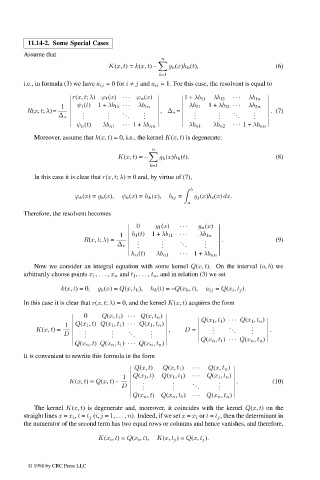Page 598 - Handbook Of Integral Equations
P. 598
11.14-2. Some Special Cases
Assume that
n
K(x, t)= k(x, t) – g k (x)h k (t), (6)
k=1
i.e., in formula (3) we have a ij = 0 for i ≠ j and a ii = 1. For this case, the resolvent is equal to
r(x, t; λ) ϕ 1 (x) ··· ϕ n (x) 1+ λb 11 λb 12 ··· λb 1n
1 ψ 1 (t) 1 + λb 11 ··· λb 1n λb 21 1+ λb 22 ··· λb 2n
R(x, t; λ)= . . . . , ∆ ∗ = . . . . . (7)
. . . . . . . .
. . . . . . . .
∆ ∗
ψ n (t) λb n1 ··· 1+ λb nn λb n1 λb n2 ··· 1+ λb nn
Moreover, assume that k(x, t) = 0, i.e., the kernel K(x, t) is degenerate:
n
K(x, t)= – g k (x)h k (t). (8)
k=1
In this case it is clear that r(x, t; λ) = 0 and, by virtue of (7),
b
ϕ k (x)= g k (x), ψ k (x)= h k (x), b ij = g j (x)h i (x) dx.
a
Therefore, the resolvent becomes
0 g 1 (x) ··· g n (x)
1 h 1 (t) 1 + λb 11 ··· λb 1n
R(x, t; λ)= . . . . . (9)
. . . .
. . . .
∆ ∗
h n (t) λb n1 ··· 1+ λb nn
Now we consider an integral equation with some kernel Q(x, t). On the interval (a, b)we
arbitrarily choose points x 1 , ... , x n and t 1 , ... , t n , and in relation (3) we set
k(x, t)=0, g k (x)= Q(x, t k ), h k (t)= –Q(x k , t), a ij = Q(x i , t j ).
In this case it is clear that r(x, t; λ) = 0, and the kernel K(x, t) acquires the form
0
Q(x, t 1 ) ··· Q(x, t n )
Q(x 1 , t 1 ) ··· Q(x 1 , t n )
1 Q(x 1 , t) Q(x 1 , t 1 ) ··· Q(x 1 , t n ) . . .
K(x, t)= . . . . , D = . . . . . . .
D . . . . . . . .
Q(x n , t) Q(x n , t 1 ) ··· Q(x n , t n )
Q(x n , t 1 ) ··· Q(x n , t n )
It is convenient to rewrite this formula in the form
Q(x, t) Q(x, t 1 ) ··· Q(x, t n )
1 Q(x 1 , t) Q(x 1 , t 1 ) ··· Q(x 1 , t n )
K(x, t)= Q(x, t) – . . . . . (10)
D . . . . .
. . .
Q(x n , t) Q(x n , t 1 ) ··· Q(x n , t n )
The kernel K(x, t) is degenerate and, moreover, it coincides with the kernel Q(x, t)onthe
straight lines x = x i , t = t j (i, j =1, ... , n). Indeed, if we set x = x i or t = t j , then the determinant in
the numerator of the second term has two equal rows or columns and hence vanishes, and therefore,
K(x i , t)= Q(x i , t), K(x, t j )= Q(x, t j ).
© 1998 by CRC Press LLC
© 1998 by CRC Press LLC
Page 581

